check engine light MERCEDES-BENZ GLA-Class 2015 X156 Owner's Manual
[x] Cancel search | Manufacturer: MERCEDES-BENZ, Model Year: 2015, Model line: GLA-Class, Model: MERCEDES-BENZ GLA-Class 2015 X156Pages: 374, PDF Size: 6.85 MB
Page 7 of 374
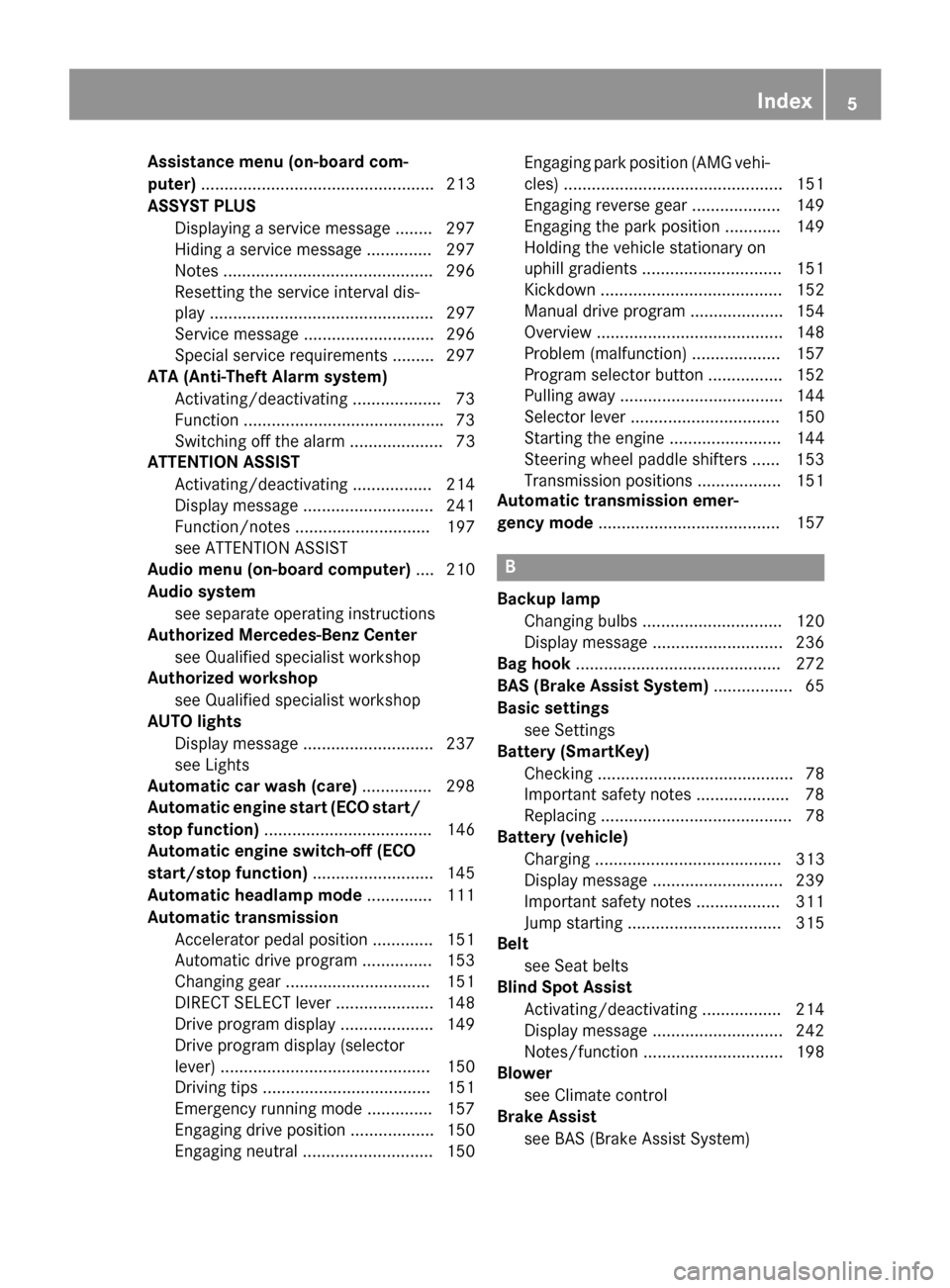
Assistance menu (on-board com-
puter)
.................................................. 213
ASSYST PLUS Displaying a service message ........ 297
Hiding a service message .............. 297
Notes ............................................ .296
Resetting the service interval dis-
play ................................................ 297
Service message ............................ 296
Special service requirements ......... 297
ATA (Anti-Theft Alarm system)
Activating/deactivating ................... 73
Function .......................................... .73
Switching off the alarm .................... 73
ATTENTION ASSIST
Activating/deactivating ................. 214
Display message ............................ 241
Function/note s............................. 197
see ATTENTION ASSIST
Audio menu (on-board computer) .... 210
Audio system see separate operating instructions
Authorized Mercedes-Benz Center
see Qualified specialist workshop
Authorized workshop
see Qualified specialist workshop
AUTO lights
Display message ............................ 237
see Lights
Automatic car wash (care) ............... 298
Automatic engine start (ECO start/
stop function) .................................... 146
Automatic engine switch-off (ECO
start/stop function) .......................... 145
Automatic headlamp mode .............. 111
Automatic transmission Accelerator pedal position ............. 151
Automatic drive program ............... 153
Changing gear ............................... 151
DIRECT SELECT lever ..................... 148
Drive program display .................... 149
Drive program display (selector
lever) ............................................. 150
Driving tips .................................... 151
Emergency running mode .............. 157
Engaging drive position .................. 150
Engaging neutral ............................ 150 Engaging park position (AMG vehi-
cles) ............................................... 151
Engaging reverse gear ................... 149
Engaging the park position ............ 149
Holding the vehicle stationary on
uphill gradients .............................. 151
Kickdown ....................................... 152
Manual drive progra m.................... 154
Overview ........................................ 148
Problem (malfunction) ................... 157
Program selector button ................ 152
Pulling away ................................... 144
Selector lever ................................ 150
Starting the engine ........................ 144
Steering wheel paddle shifters ...... 153
Transmission positions .................. 151
Automatic transmission emer-
gency mode ....................................... 157 B
Backup lamp Changing bulbs .............................. 120
Display message ............................ 236
Bag hook ............................................ 272
BAS (Brake Assist System) ................. 65
Basic settings see Settings
Battery (SmartKey)
Checking .......................................... 78
Important safety notes .................... 78
Replacing ......................................... 78
Battery (vehicle)
Charging ........................................ 313
Display message ............................ 239
Important safety notes .................. 311
Jump starting ................................. 315
Belt
see Seat belts
Blind Spot Assist
Activating/deactivating ................. 214
Display message ............................ 242
Notes/function .............................. 198
Blower
see Climate control
Brake Assist
see BAS (Brake Assist System) Index
5
Page 9 of 374
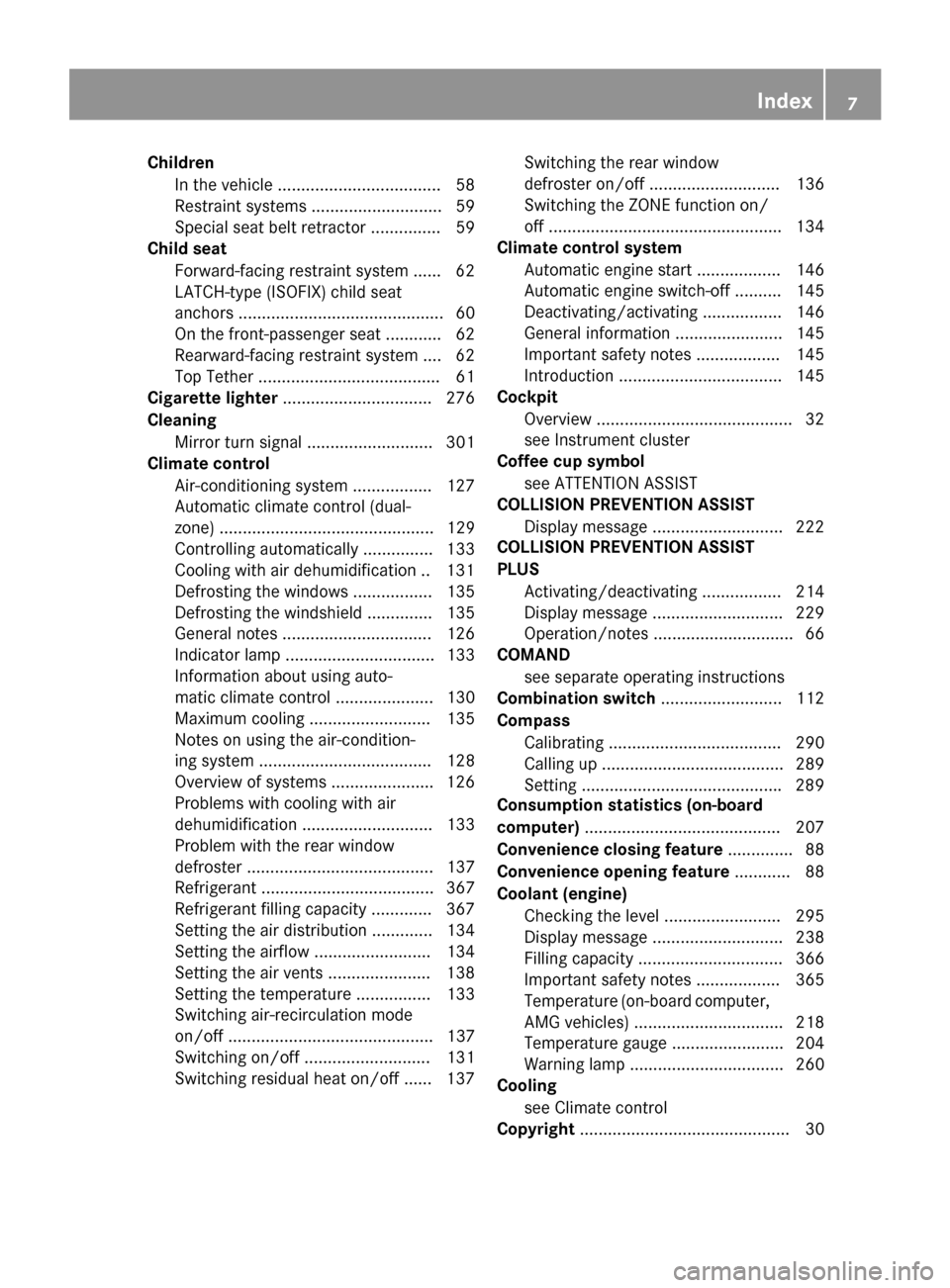
Children
In the vehicle .................................. .58
Restraint systems ............................ 59
Special seat belt retractor .............. .59
Child seat
Forward-facing restraint system ...... 62
LATCH-type (ISOFIX) child seat
anchors ............................................ 60
On the front-passenger seat ............ 62
Rearward-facing restraint system .... 62
Top Tether ...................................... .61
Cigarette lighter ................................ 276
Cleaning Mirror turn signal .......................... .301
Climate control
Air-conditioning system ................. 127
Automatic climate control (dual-
zone) .............................................. 129
Controlling automatically .............. .133
Cooling with air dehumidification .. 131
Defrosting the windows ................. 135
Defrosting the windshield .............. 135
General notes ................................ 126
Indicator lamp ................................ 133
Information about using auto-
matic climate control ..................... 130
Maximum cooling .......................... 135
Notes on using the air-condition-
ing system ..................................... 128
Overview of systems ..................... .126
Problems with cooling with air
dehumidification ............................ 133
Problem with the rear window
defroster ........................................ 137
Refrigerant ..................................... 367
Refrigerant filling capacity ............. 367
Setting the air distribution ............. 134
Setting the airflow ......................... 134
Setting the air vents ..................... .138
Setting the temperature ................ 133
Switching air-recirculation mode
on/off ............................................ 137
Switching on/off ........................... 131
Switching residual heat on/off ...... 137 Switching the rear window
defroster on/off ............................ 136
Switching the ZONE function on/
off .................................................
.134
Climate control system
Automatic engine start .................. 146
Automatic engine switch-off .......... 145
Deactivating/activating ................. 146
General information ....................... 145
Important safety notes .................. 145
Introduction ................................... 145
Cockpit
Overview .......................................... 32
see Instrument cluster
Coffee cup symbol
see ATTENTION ASSIST
COLLISION PREVENTION ASSIST
Display message ............................ 222
COLLISION PREVENTION ASSIST
PLUS
Activating/deactivating ................. 214
Display message ............................ 229
Operation/notes .............................. 66
COMAND
see separate operating instructions
Combination switch .......................... 112
Compass Calibrating ..................................... 290
Calling up ....................................... 289
Setting .......................................... .289
Consumption statistics (on-board
computer) .......................................... 207
Convenience closing feature .............. 88
Convenience opening feature ............ 88
Coolant (engine) Checking the level ......................... 295
Display message ............................ 238
Filling capacity ............................... 366
Important safety notes .................. 365
Temperature (on-board computer, AMG vehicles) ................................ 218
Temperature gauge ........................ 204
Warning lamp ................................. 260
Cooling
see Climate control
Copyright ............................................. 30 Index
7
Page 12 of 374
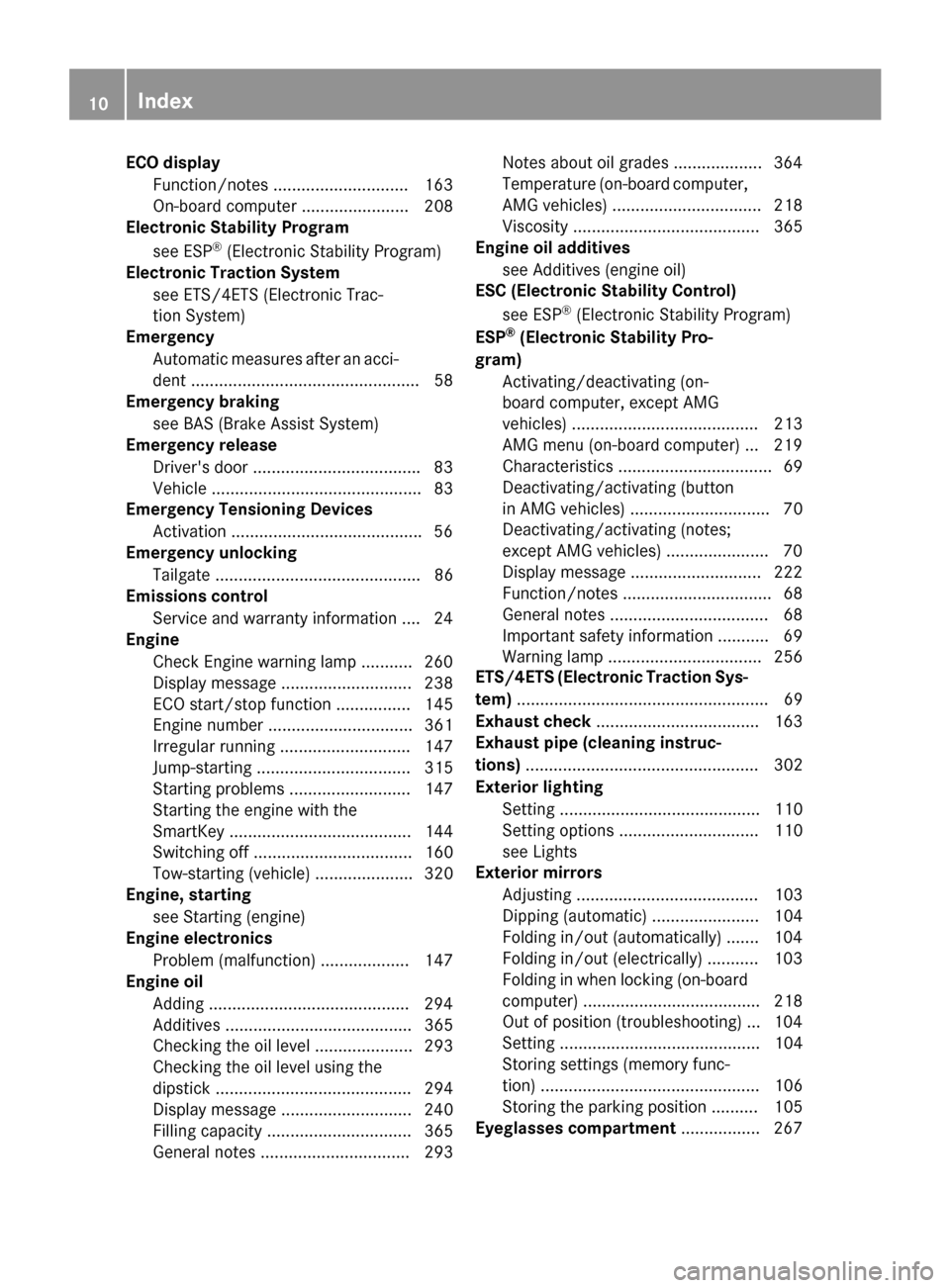
ECO display
Function/notes ............................ .163
On-board computer ....................... 208
Electronic Stability Program
see ESP ®
(Electronic Stability Program)
Electronic Traction System
see ETS/4ETS (Electronic Trac-
tion System)
Emergency
Automatic measures after an acci-
dent ................................................. 58
Emergency braking
see BAS (Brake Assist System)
Emergency release
Driver's door ................................... .83
Vehicle .............................................83
Emergency Tensioning Devices
Activation ........................................ .56
Emergency unlocking
Tailgat e ............................................ 86
Emissions control
Service and warranty information .... 24
Engine
Check Engine warning lamp .......... .260
Display message ............................ 238
ECO start/stop function ................ 145
Engine number ............................... 361
Irregular running ............................ 147
Jump-starting ................................. 315
Starting problems .......................... 147
Starting the engine with the
SmartKey ....................................... 144
Switching off .................................. 160
Tow-starting (vehicle) ..................... 320
Engine, starting
see Starting (engine)
Engine electronics
Problem (malfunction) ................... 147
Engine oil
Adding .......................................... .294
Additives ........................................ 365
Checking the oil level ..................... 293
Checking the oil level using the
dipstick .......................................... 294
Display message ............................ 240
Filling capacity ............................... 365
General notes ................................ 293 Notes about oil grades ................... 364
Temperature (on-board computer,
AMG vehicles) ................................ 218
Viscosity ........................................ 365
Engine oil additives
see Additives (engine oil)
ESC (Electronic Stability Control)
see ESP ®
(Electronic Stability Program)
ESP ®
(Electronic Stability Pro-
gram) Activating/deactivating (on-
board computer, except AMG
vehicles) ........................................ 213
AMG menu (on-board computer) ... 219
Characteristics ................................. 69
Deactivating/activating (button
in AMG vehicles) .............................. 70
Deactivating/activating (notes;
except AMG vehicles) ..................... .70
Display message ............................ 222
Function/note s................................ 68
General notes .................................. 68
Important safety information ........... 69
Warning lamp ................................. 256
ETS/4ETS (Electronic Traction Sys-
tem) ...................................................... 69
Exhaust check ................................... 163
Exhaust pipe (cleaning instruc-
tions) .................................................. 302
Exterior lighting Setting ........................................... 110
Setting options .............................. 110
see Lights
Exterior mirrors
Adjusting ....................................... 103
Dipping (automatic) ....................... 104
Folding in/out (automatically )....... 104
Folding in/out (electrically) ........... 103
Folding in when locking (on-board computer) ...................................... 218
Out of position (troubleshooting) ... 104
Setting ........................................... 104
Storing settings (memory func-
tion) ............................................... 106
Storing the parking position .......... 105
Eyeglasses compartment ................. 26710
Index
Page 16 of 374
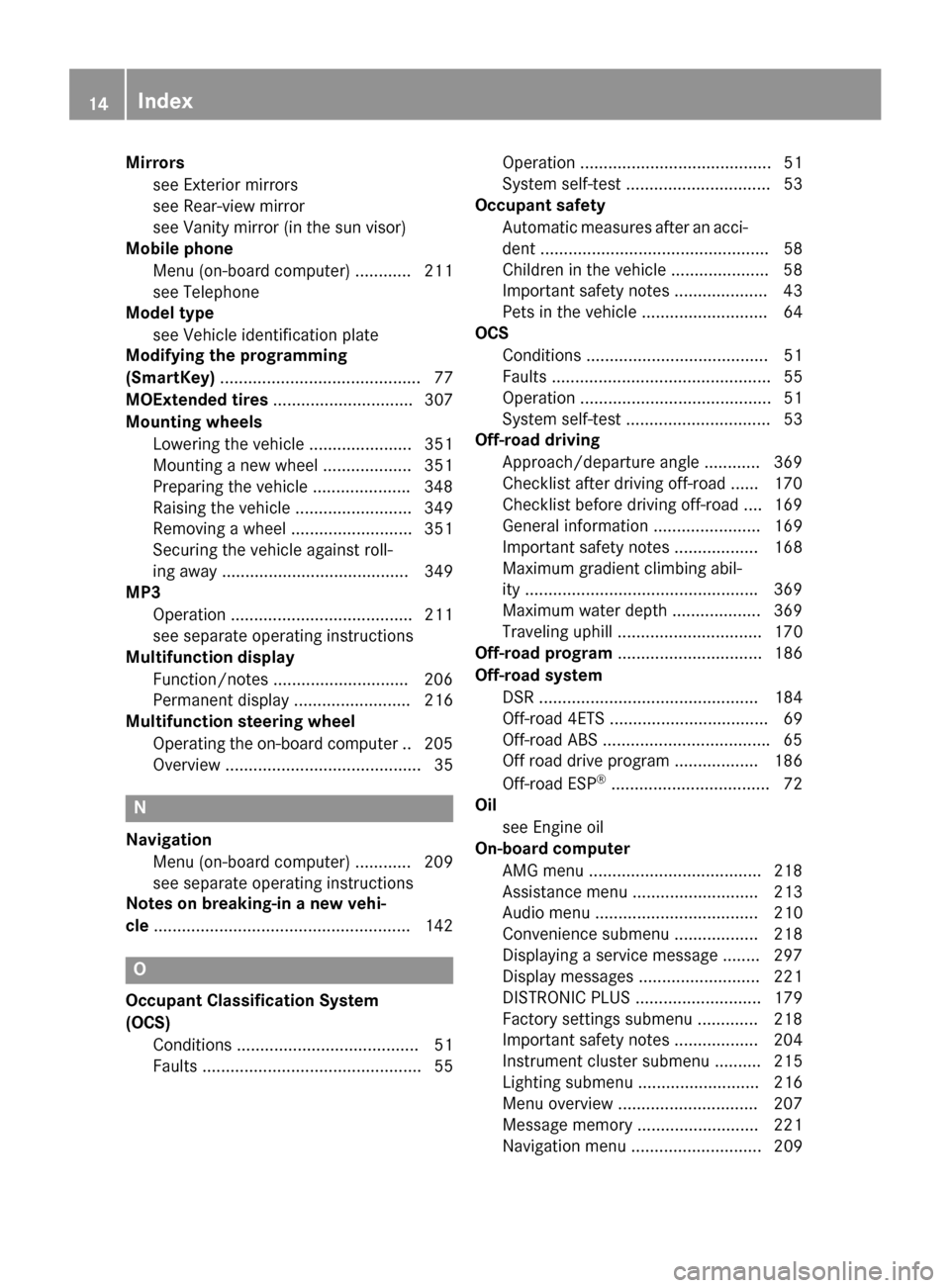
Mirrors
see Exterior mirrors
see Rear-view mirror
see Vanity mirror (in the sun visor)
Mobile phone
Menu (on-board computer) ............ 211
see Telephone
Model type
see Vehicle identification plate
Modifying the programming
(SmartKey) ........................................... 77
MOExtended tires .............................. 307
Mounting wheels Lowering the vehicle ...................... 351
Mounting a new wheel ................... 351
Preparing the vehicle .................... .348
Raising the vehicle ......................... 349
Removing a wheel .......................... 351
Securing the vehicle against roll-
ing away ........................................ 349
MP3
Operation ....................................... 211
see separate operating instructions
Multifunction display
Function/notes ............................ .206
Permanent display ......................... 216
Multifunction steering wheel
Operating the on-board computer .. 205
Overview .......................................... 35 N
Navigation Menu (on-board computer) ............ 209
see separate operating instructions
Notes on breaking-in a new vehi-
cle ....................................................... 142 O
Occupant Classification System
(OCS) Conditions ....................................... 51
Faults ............................................... 55 Operation ......................................... 51
System self-test ............................... 53
Occupant safety
Automatic measures after an acci-
dent ................................................. 58
Children in the vehicle ..................... 58
Important safety notes .................... 43
Pets in the vehicle ........................... 64
OCS
Conditions ....................................... 51
Faults ............................................... 55
Operation ......................................... 51
System self-test ............................... 53
Off-road driving
Approach/departure angle ............ 369
Checklist after driving off-road ...... 170
Checklist before driving off-road .... 169
General information ....................... 169
Important safety notes .................. 168
Maximum gradient climbing abil-
ity ................................................. .369
Maximum water depth ................... 369
Traveling uphill ............................... 170
Off-road program ............................... 186
Off-road system DSR ............................................... 184
Off-road 4ETS .................................. 69
Off-road ABS ................................... .65
Off road drive program .................. 186
Off-road ESP ®
..................................72
Oil
see Engine oil
On-board computer
AMG menu .....................................2 18
Assistance menu ........................... 213
Audio menu ................................... 210
Convenience submenu .................. 218
Displaying a service message ....... .297
Display messages .......................... 221
DISTRONIC PLUS ........................... 179
Factory settings submenu ............. 218
Important safety notes .................. 204
Instrument cluster submenu .......... 215
Lighting submenu .......................... 216
Menu overview .............................. 207
Message memory .......................... 221
Navigation menu ............................ 209 14
Index
Page 45 of 374
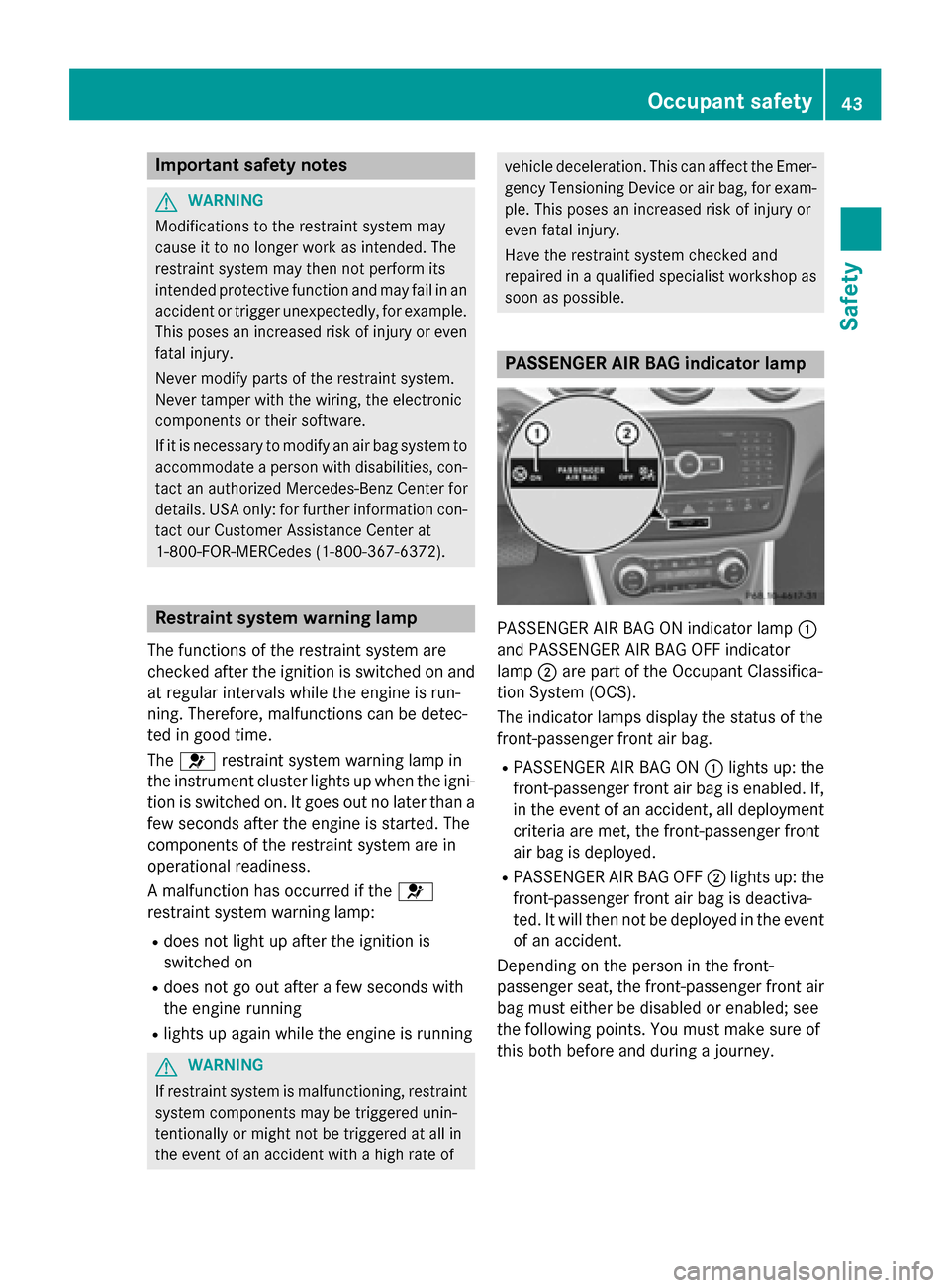
Important safety notes
G
WARNING
Modifications to the restraint system may
cause it to no longer work as intended. The
restraint system may then not perform its
intended protective function and may fail in an accident or trigger unexpectedly, for example.
This poses an increased risk of injury or even fatal injury.
Never modify parts of the restraint system.
Never tamper with the wiring, the electronic
components or their software.
If it is necessary to modify an air bag system to
accommodate a person with disabilities, con- tact an authorized Mercedes-Benz Center for
details. USA only: for further information con- tact our Customer Assistance Center at
1-800-FOR-MERCedes (1 ‑800‑367‑6372).Restraint system warning lamp
The functions of the restraint system are
checked after the ignition is switched on and
at regular intervals while the engine is run-
ning. Therefore, malfunctions can be detec-
ted in good time.
The 0075 restraint system warning lamp in
the instrument cluster lights up when the igni- tion is switched on. It goes out no later than afew seconds after the engine is started. The
components of the restraint system are in
operational readiness.
A malfunction has occurred if the 0075
restraint system warning lamp:
R does not light up after the ignition is
switched on
R does not go out after a few seconds with
the engine running
R lights up again while the engine is running G
WARNING
If restraint system is malfunctioning, restraint system components may be triggered unin-
tentionally or might not be triggered at all in
the event of an accident with a high rate of vehicle deceleration. This can affect the Emer-
gency Tensioning Device or air bag, for exam-
ple. This poses an increased risk of injury or
even fatal injury.
Have the restraint system checked and
repaired in a qualified specialist workshop as
soon as possible. PASSENGER AIR BAG indicator lamp
PASSENGER AIR BAG ON indicator lamp
0043
and PASSENGER AIR BAG OFF indicator
lamp 0044are part of the Occupant Classifica-
tion System (OCS).
The indicator lamps display the status of the
front-passenger front air bag.
R PASSENGER AIR BAG ON 0043lights up: the
front-passenger front air bag is enabled. If,
in the event of an accident, all deployment
criteria are met, the front-passenger front
air bag is deployed.
R PASSENGER AIR BAG OFF 0044lights up: the
front-passenger front air bag is deactiva-
ted. It will then not be deployed in the event of an accident.
Depending on the person in the front-
passenger seat, the front-passenger front air
bag must either be disabled or enabled; see
the following points. You must make sure of
this both before and during a journey. Occupant safety
43Safety Z
Page 67 of 374
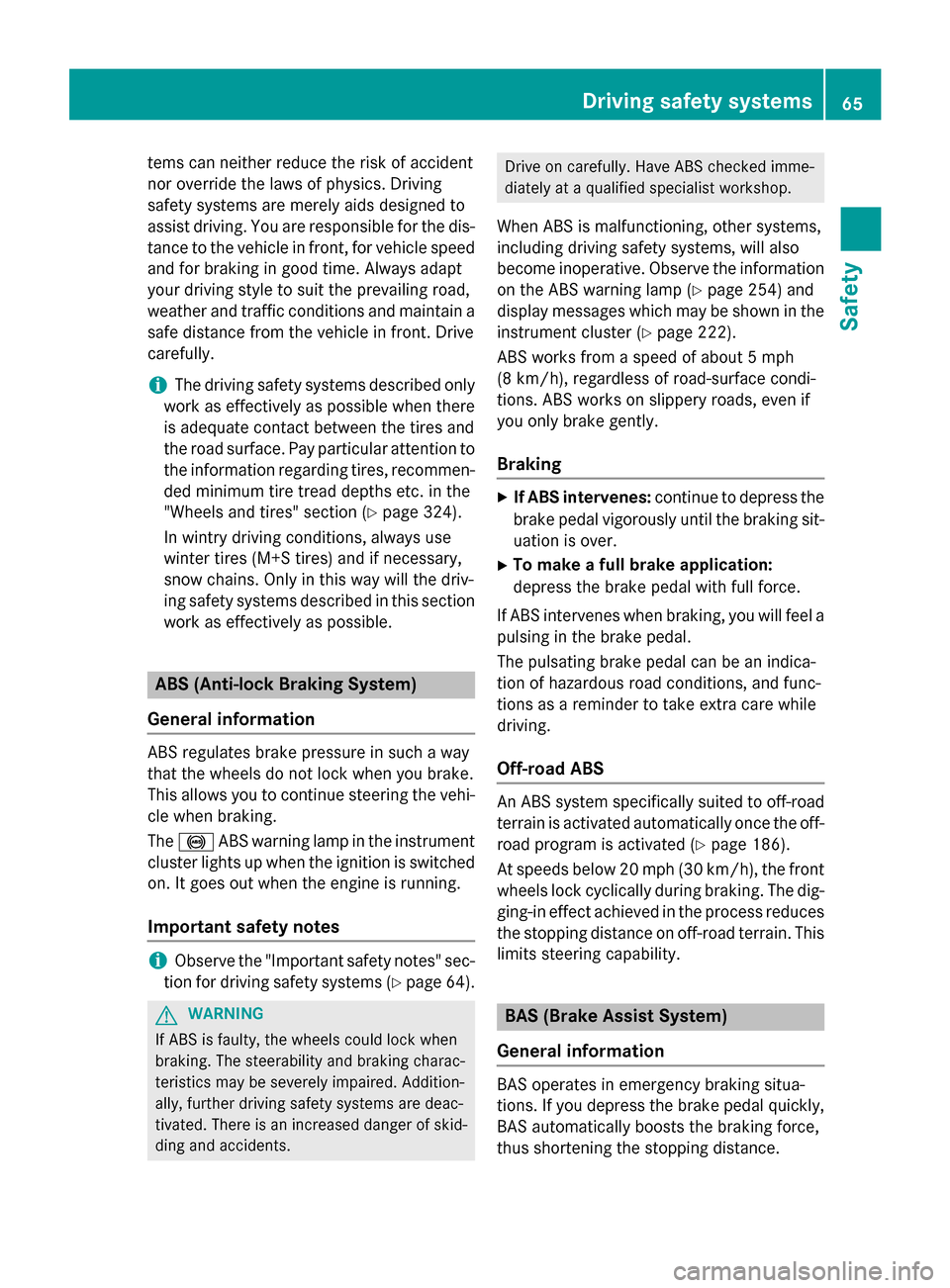
tems can neither reduce the risk of accident
nor override the laws of physics. Driving
safety systems are merely aids designed to
assist driving. You are responsible for the dis-
tance to the vehicle in front, for vehicle speed and for braking in good time. Always adapt
your driving style to suit the prevailing road,
weather and traffic conditions and maintain a
safe distance from the vehicle in front. Drive
carefully.
i The driving safety systems described only
work as effectively as possible when there
is adequate contact between the tires and
the road surface. Pay particular attention to
the information regarding tires, recommen- ded minimum tire tread depths etc. in the
"Wheels and tires" section (Y page 324).
In wintry driving conditions, always use
winter tires (M+S tires ) and ifnecessary,
snow chains. Only in this way will the driv-
ing safety systems described in this section work as effectively as possible. ABS (Anti-lock Braking System)
General information ABS regulates brake pressure in such a way
that the wheels do not lock when you brake.
This allows you to continue steering the vehi-
cle when braking.
The 0025 ABS warning lamp in the instrument
cluster lights up when the ignition is switched
on. It goes out when the engine is running.
Important safety notes i
Observe the "Important safety notes" sec-
tion for driving safety systems (Y page 64).G
WARNING
If ABS is faulty, the wheels could lock when
braking. The steerability and braking charac-
teristics may be severely impaired. Addition-
ally, further driving safety systems are deac-
tivated. There is an increased danger of skid- ding and accidents. Drive on carefully. Have ABS checked imme-
diately at a qualified specialist workshop.
When ABS is malfunctioning, other systems,
including driving safety systems, will also
become inoperative. Observe the information on the ABS warning lamp (Y page 254) and
display messages which may be shown in the
instrument cluster (Y page 222).
ABS works from a speed of about 5 mph
(8 km/h), regardless of road-surface condi-
tions. ABS works on slippery roads, even if
you only brake gently.
Braking X
If ABS intervenes: continue to depress the
brake pedal vigorously until the braking sit- uation is over.
X To make a full brake application:
depress the brake pedal with full force.
If ABS intervenes when braking, you will feel a pulsing in the brake pedal.
The pulsating brake pedal can be an indica-
tion of hazardous road conditions, and func-
tions as a reminder to take extra care while
driving.
Off-road ABS An ABS system specifically suited to off-road
terrain is activated automatically once the off-
road program is activated (Y page 186).
At speeds below 20 mph (30 km/h), the front
wheels lock cyclically during braking. The dig-
ging-in effect achieved in the process reduces the stopping distance on off-road terrain. This
limits steering capability. BAS (Brake Assist System)
General information BAS operates in emergency braking situa-
tions. If you depress the brake pedal quickly,
BAS automatically boosts the braking force,
thus shortening the stopping distance. Driving safety systems
65Safety Z
Page 71 of 374
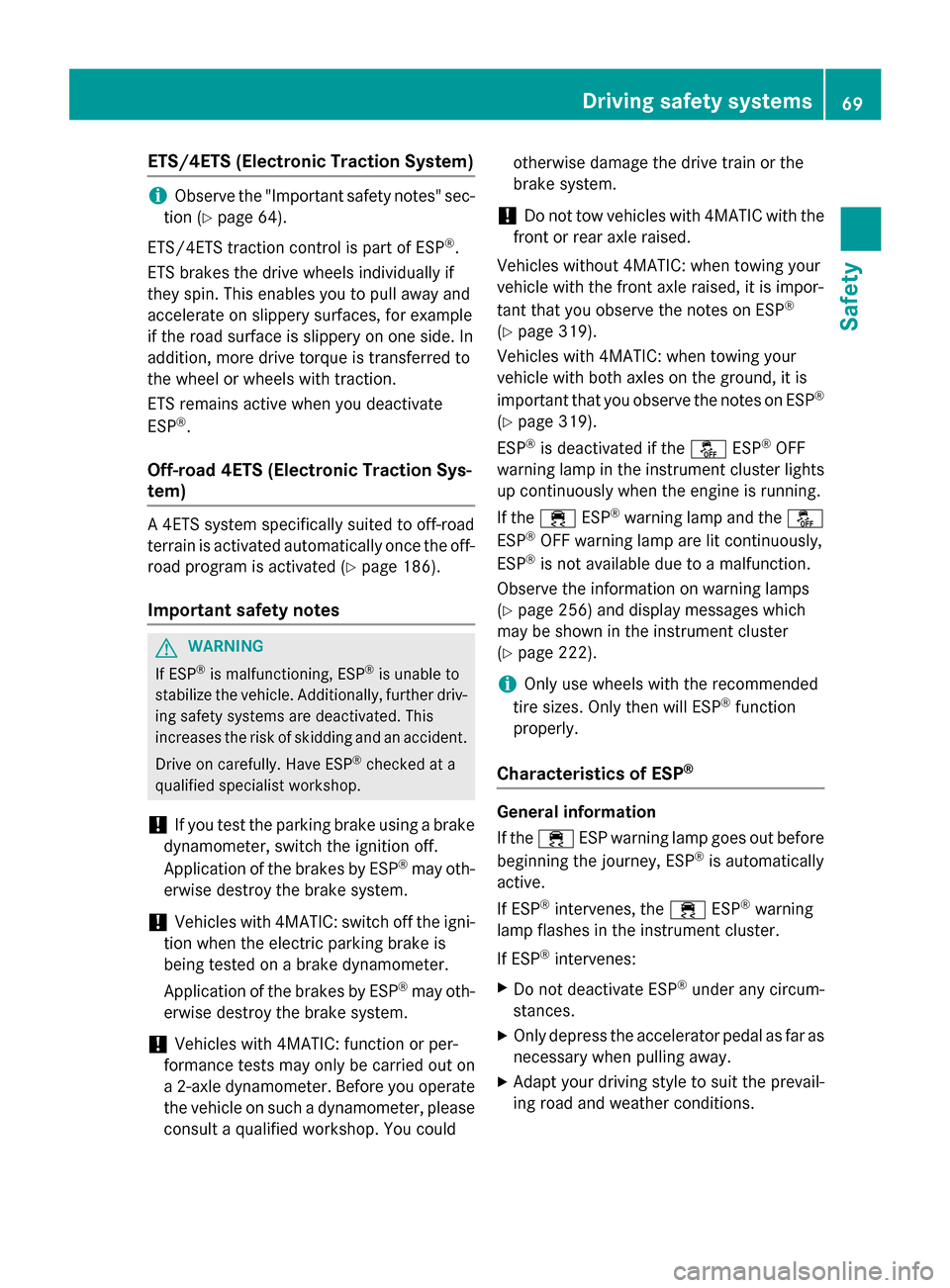
ETS/4ETS (Electronic Traction System)
i
Observe the "Important safety notes" sec-
tion (Y page 64).
ETS/4ETS traction control is part of ESP ®
.
ETS brakes the drive wheels individually if
they spin. This enables you to pull away and
accelerate on slippery surfaces, for example
if the road surface is slippery on one side. In
addition, more drive torque is transferred to
the wheel or wheels with traction.
ETS remains active when you deactivate
ESP ®
.
Off-road 4ETS (Electronic Traction Sys-
tem) A 4ETS system specifically suited to off-road
terrain is activated automatically once the off-
road program is activated (Y page 186).
Important safety notes G
WARNING
If ESP ®
is malfunctioning, ESP ®
is unable to
stabilize the vehicle. Additionally, further driv- ing safety systems are deactivated. This
increases the risk of skidding and an accident.
Drive on carefully. Have ESP ®
checked at a
qualified specialist workshop.
! If you test the parking brake using a brake
dynamometer, switch the ignition off.
Application of the brakes by ESP ®
may oth-
erwise destroy the brake system.
! Vehicles with 4MATIC: switch off the igni-
tion when the electric parking brake is
being tested on a brake dynamometer.
Application of the brakes by ESP ®
may oth-
erwise destroy the brake system.
! Vehicles with 4MATIC: function or per-
formance tests may only be carried out on
a 2-axle dynamometer. Before you operate the vehicle on such a dynamometer, please
consult a qualified workshop. You could otherwise damage the drive train or the
brake system.
! Do not tow vehicles with 4MATIC with the
front or rear axle raised.
Vehicles without 4MATIC: when towing your
vehicle with the front axle raised, it is impor-
tant that you observe the notes on ESP ®
(Y page 319).
Vehicles with 4MATIC: when towing your
vehicle with both axles on the ground, it is
important that you observe the notes on ESP ®
(Y page 319).
ESP ®
is deactivated if the 00BBESP®
OFF
warning lamp in the instrument cluster lights
up continuously when the engine is running.
If the 00E5 ESP®
warning lamp and the 00BB
ESP ®
OFF warning lamp are lit continuously,
ESP ®
is not available due to a malfunction.
Observe the information on warning lamps
(Y page 256) and display messages which
may be shown in the instrument cluster
(Y page 222).
i Only use wheels with the recommended
tire sizes. Only then will ESP ®
function
properly.
Characteristics of ESP ® General information
If the
00E5 ESP warning lamp goes out before
beginning the journey, ESP ®
is automatically
active.
If ESP ®
intervenes, the 00E5ESP®
warning
lamp flashes in the instrument cluster.
If ESP ®
intervenes:
X Do not deactivate ESP ®
under any circum-
stances.
X Only depress the accelerator pedal as far as
necessary when pulling away.
X Adapt your driving style to suit the prevail-
ing road and weather conditions. Driving safety systems
69Safety Z
Page 74 of 374

If you deactivate ESP
®
:
R ESP ®
no longer improves driving stability.
R engine torque is no longer limited and the
drive wheels are able to spin.
The spinning of the wheels results in a cut-
ting action for better traction on loose sur-faces.
R traction control is still activated.
R PRE-SAFE ®
is no longer available, nor is it
activated if you brake firmly and ESP ®
intervenes.
R COLLISION PREVENTION ASSIST is no lon-
ger available; nor is it activated if you brake
firmly with assistance from ESP ®
.
R ESP ®
still provides support when you
brake.
Off-road ESP ® An ESP
®
system specifically suited to off-road
terrain is activated automatically once the off- road program is activated (Y page 186).
Off-road ESP ®
intervenes with a delay if there
is oversteering or understeering, thus improv-
ing traction. EBD (electronic brake force distribu-
tion)
General information EBD monitors and controls the brake pres-
sure on the rear wheels to improve driving
stability while braking.
Important safety notes i
Observe the "Important safety notes" sec-
tion for driving safety systems (Y page 64).G
WARNING
If EBD has malfunctioned, the rear wheels can still lock, e.g. under full braking. This increa-
ses the risk of skidding and an accident.
You should therefore adapt your driving style
to the different handling characteristics. Have the brake system checked at a qualified spe-
cialist workshop.
Observe information regarding indicator and
warning lamps (Y page 254) as well as dis-
play messages (Y page 224). ADAPTIVE BRAKE
ADAPTIVE BRAKE enhances braking safety
and offers increased braking comfort. In addi-
tion to the braking function, ADAPTIVE BRAKE
also has the HOLD function (Y page 181) and
hill start assist (Y page 144). For further
information, see Driving tips (Y page 164). STEER CONTROL
General information STEER CONTROL helps you by transmitting a
noticeable steering force to the steering
wheel in the direction required for vehicle
stabilization.
This steering assistance is provided in partic- ular if:
R both right wheels or both left wheels are on
a wet or slippery road surface when you
brake.
R the vehicle starts to skid.
Important safety notes No steering support is provided from STEER
CONTROL, if:
R ESP ®
is malfunctioning.
R the lighting is faulty.
Power steering will, however, continue to
function. Protection against theft
Immobilizer
The immobilizer prevents your vehicle from
being started without the correct SmartKey. 72
Protection against theftSafety
Page 83 of 374

Problem
Possible causes/consequences and
0050
0050Solutions The engine cannot be
started using the
SmartKey. The on-board voltage is too low.
X Switch off non-essential consumers, e.g. seat heating or interior
lighting, and try to start the engine again.
If this does not work:
X Check the starter battery and charge it if necessary
(Y page 311).
or
X Jump-start the vehicle (Y page 315).
or
X Consult a qualified specialist workshop. The engine cannot be
started using the
SmartKey. The steering lock is mechanically blocked.
X Remove the SmartKey and reinsert it into the ignition lock. While
doing this, turn the steering wheel in both directions. Doors
Important safety notes
G
WARNING
If children are left unsupervised in the vehicle, they could:
R open the doors, thus endangering other
people or road users.
R get out and disrupt traffic.
R operate the vehicle's equipment.
Additionally, children could set the vehicle in
motion if, for example, they:
R release the parking brake.
R shifting the automatic transmission out of
park position P
R Start the engine.
There is a risk of an accident and injury.
When leaving the vehicle, always take the
SmartKey with you and lock the vehicle. Never
leave children or animals unattended in the
vehicle. Always keep the SmartKey out of
reach of children. You should preferably place luggage or loads
in the cargo compartment. Observe the load-
ing guidelines (Y page 266). Unlocking and opening doors from
the inside
X
To unlock and open a front door: pull
door handle 0044.
If the door is locked, locking knob 0043pops
up. The door is unlocked and opens.
X To unlock a rear door: pull up locking
knob 0043.
The door is unlocked and can be opened.
X To open a rear door: pull door handle0044. Doors
81Opening and closing Z
Page 98 of 374
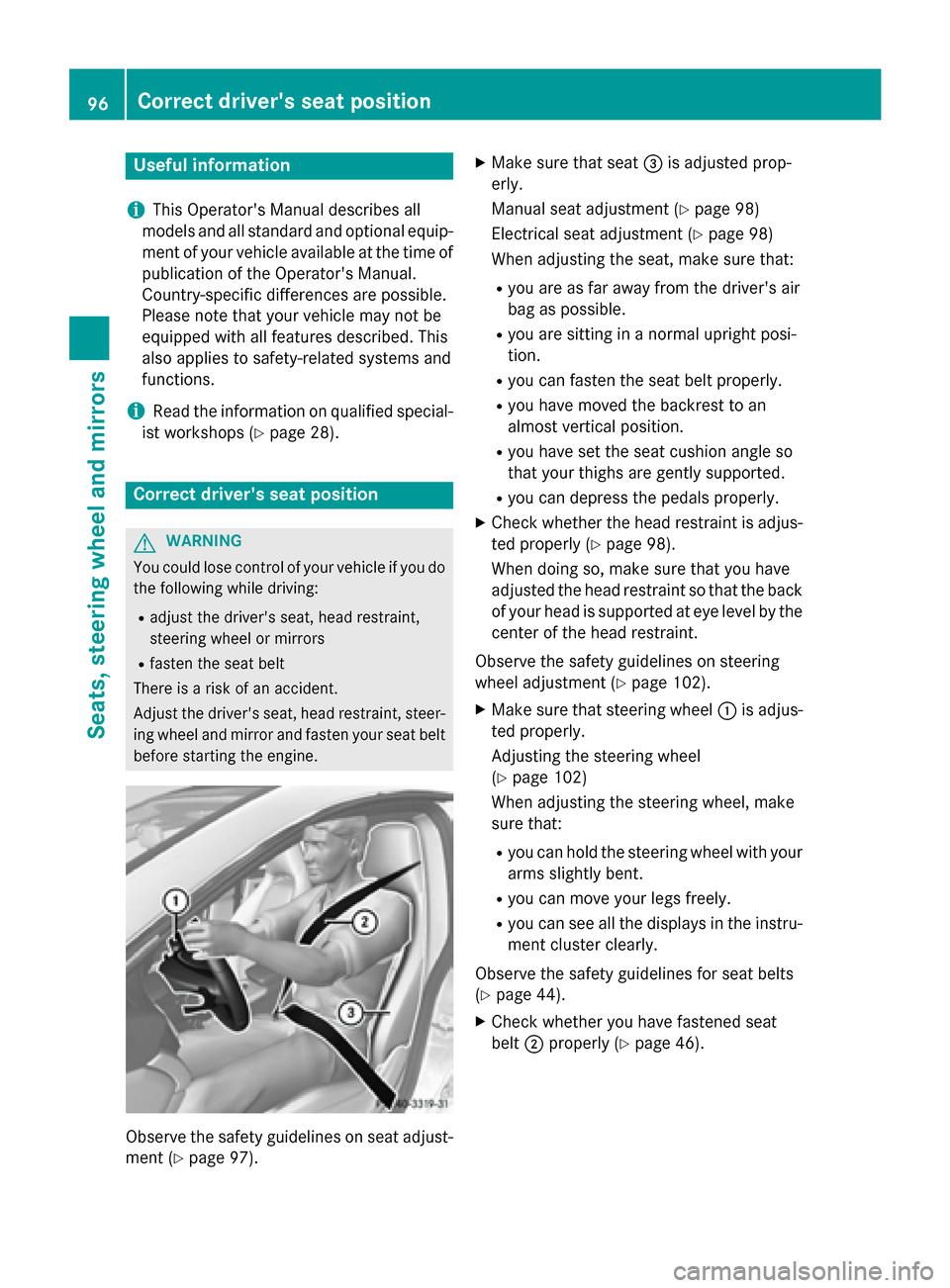
Useful information
i This Operator's Manual describes all
models and all standard and optional equip- ment of your vehicle available at the time of
publication of the Operator's Manual.
Country-specific differences are possible.
Please note that your vehicle may not be
equipped with all features described. This
also applies to safety-related systems and
functions.
i Read the information on qualified special-
ist workshops (Y page 28). Correct driver's seat position
G
WARNING
You could lose control of your vehicle if you do the following while driving:
R adjust the driver's seat, head restraint,
steering wheel or mirrors
R fasten the seat belt
There is a risk of an accident.
Adjust the driver's seat, head restraint, steer-
ing wheel and mirror and fasten your seat belt before starting the engine. Observe the safety guidelines on seat adjust-
ment (Y page 97). X
Make sure that seat 0087is adjusted prop-
erly.
Manual seat adjustment (Y page 98)
Electrical seat adjustment (Y page 98)
When adjusting the seat, make sure that:
R you are as far away from the driver's air
bag as possible.
R you are sitting in a normal upright posi-
tion.
R you can fasten the seat belt properly.
R you have moved the backrest to an
almost vertical position.
R you have set the seat cushion angle so
that your thighs are gently supported.
R you can depress the pedals properly.
X Check whether the head restraint is adjus-
ted properly (Y page 98).
When doing so, make sure that you have
adjusted the head restraint so that the back
of your head is supported at eye level by the center of the head restraint.
Observe the safety guidelines on steering
wheel adjustment (Y page 102).
X Make sure that steering wheel 0043is adjus-
ted properly.
Adjusting the steering wheel
(Y page 102)
When adjusting the steering wheel, make
sure that:
R you can hold the steering wheel with your
arms slightly bent.
R you can move your legs freely.
R you can see all the displays in the instru-
ment cluster clearly.
Observe the safety guidelines for seat belts
(Y page 44).
X Check whether you have fastened seat
belt 0044properly (Y page 46). 96
Correct driver's seat positionSeats, steering wheel and mirrors